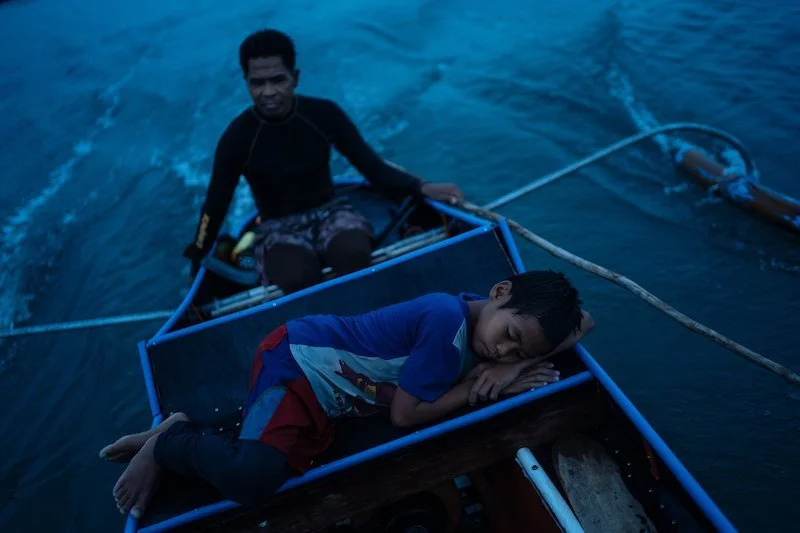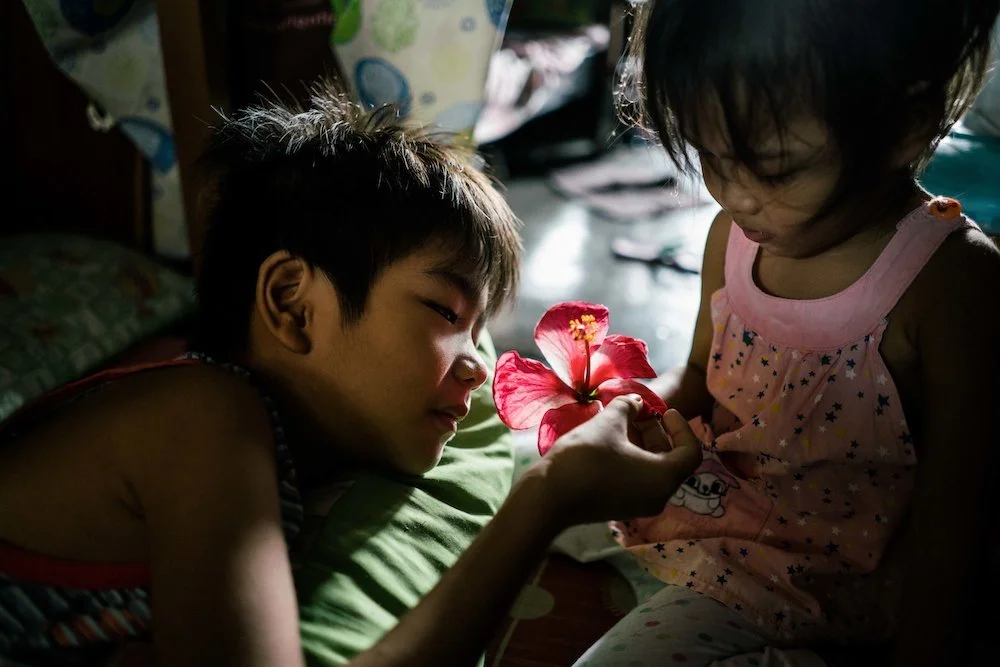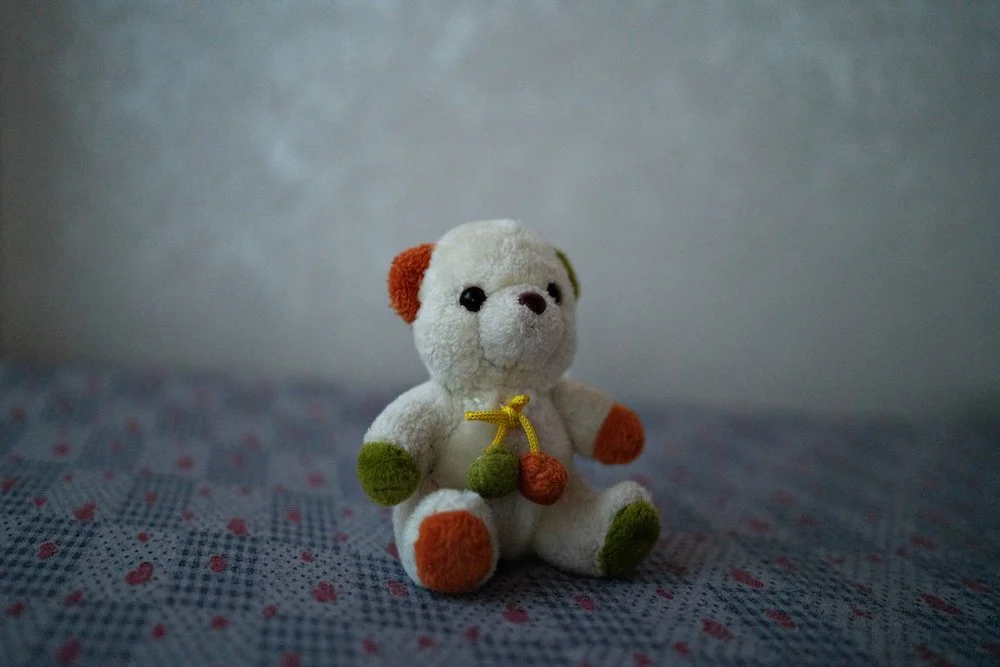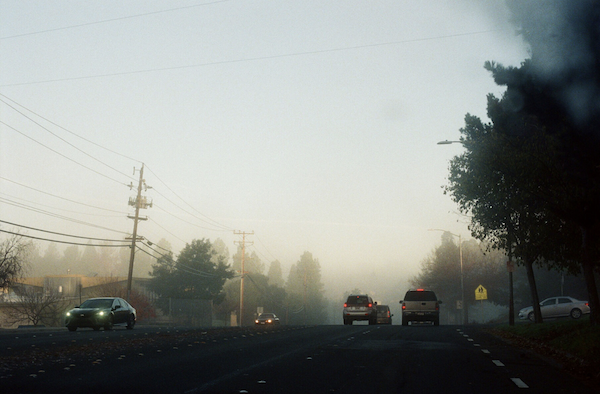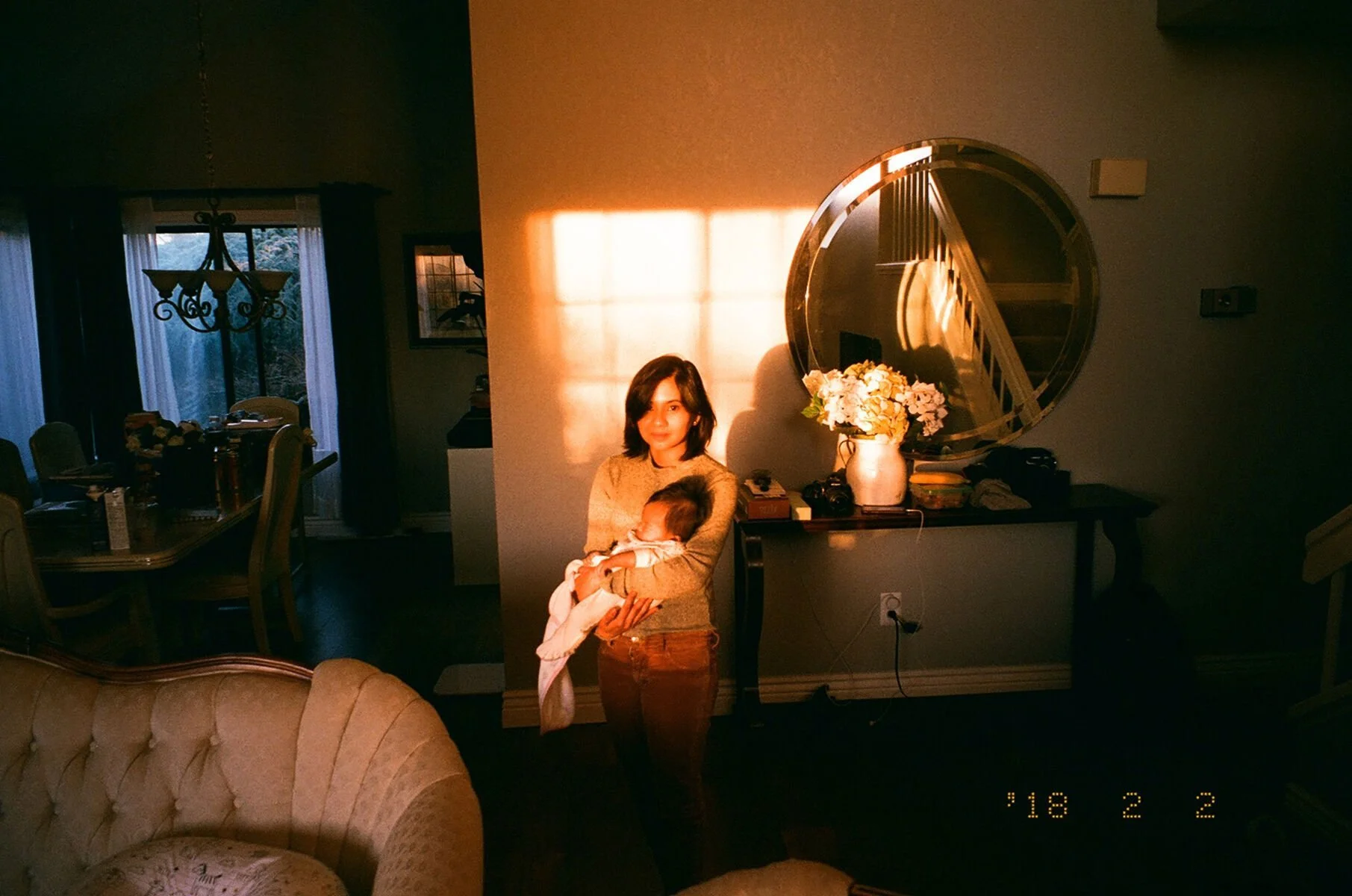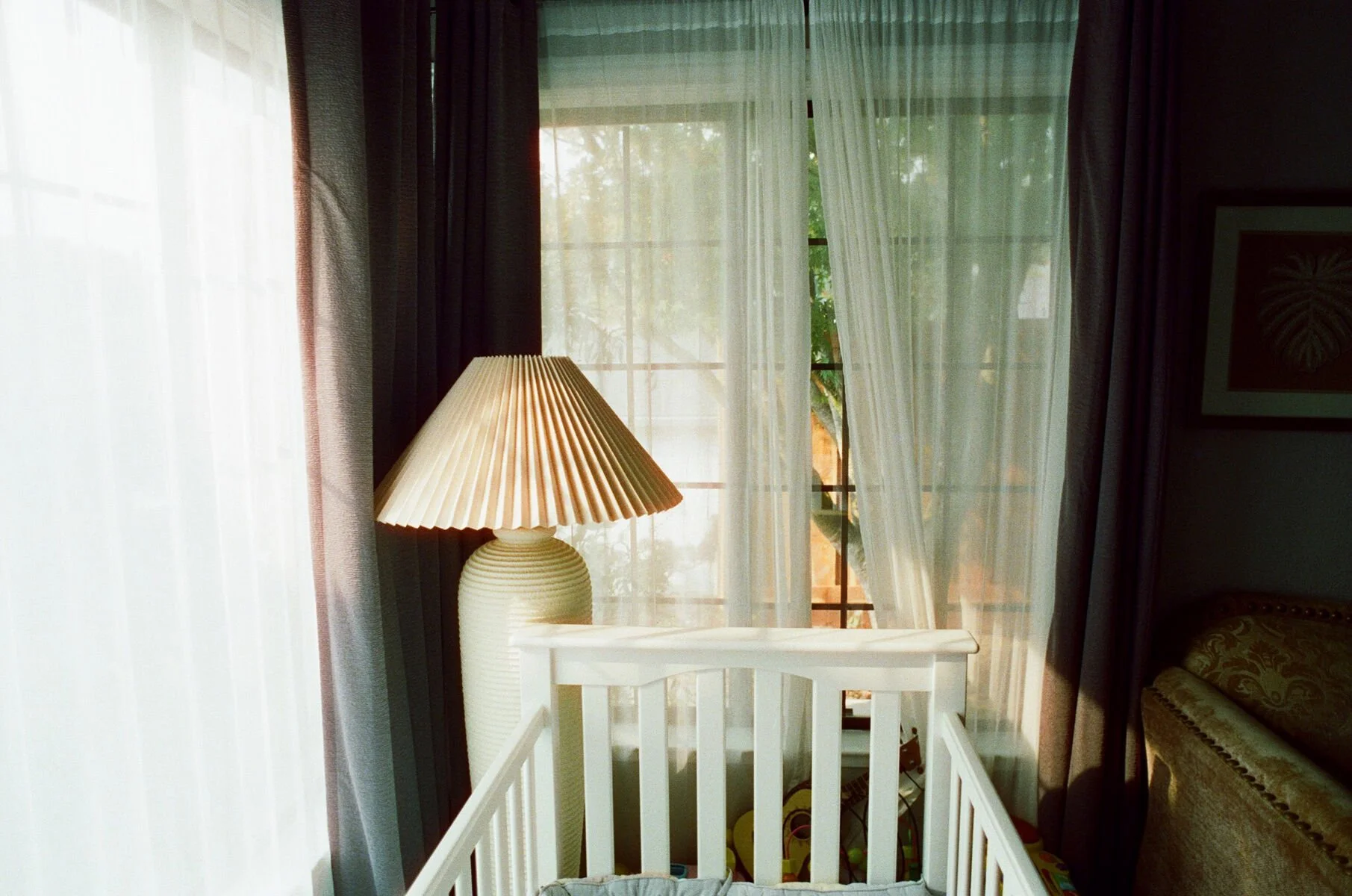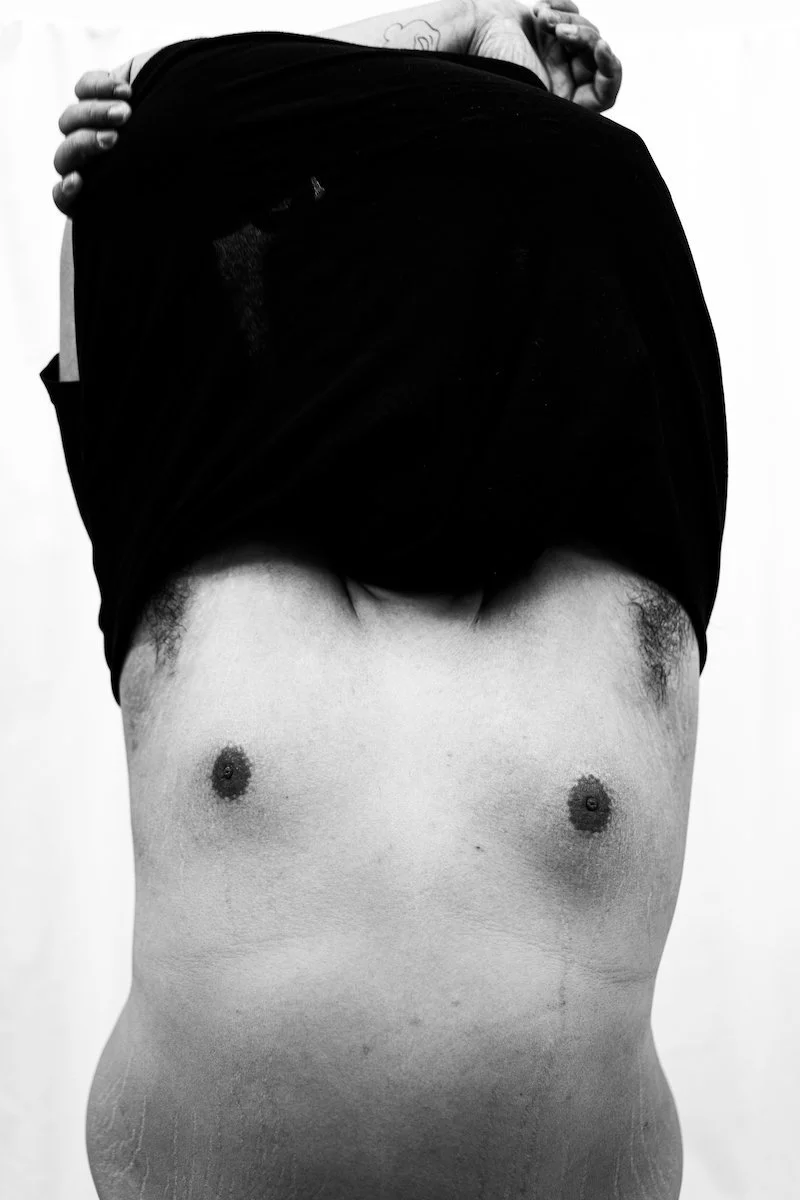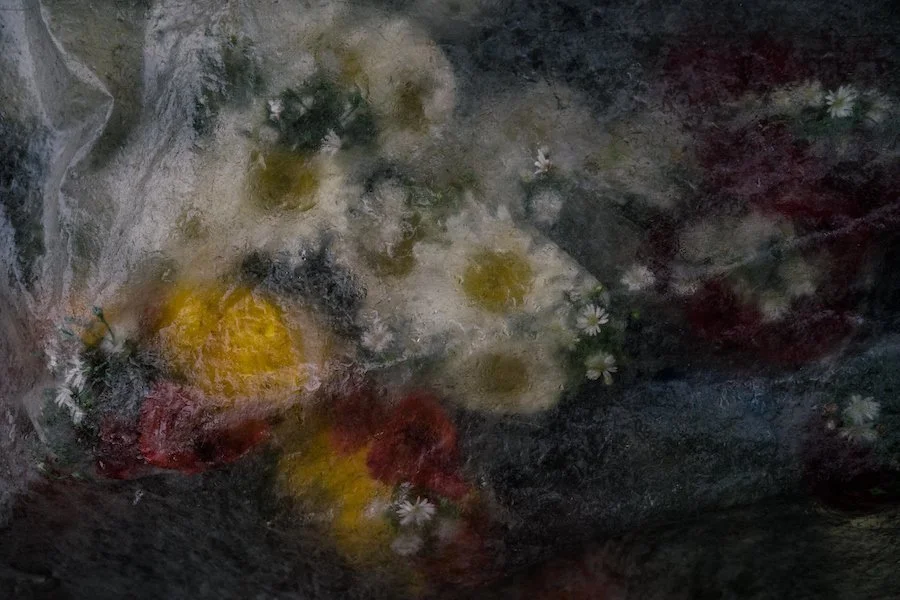In the Philippines, Photographs of Tenderness Help Us Not to Look Away
Hannah Reyes Morales, Geloy Concepcion, JL Javier
Hannah Reyes Morales, Zaijan Villaruel rests after fishing with his father Umbing in Bataan, Philippines. The image is part of Hannah Reyes Morales’ long-term project Living Lullabies, which “explores the role of lullabies in creating safer spaces for children and caregivers in challenging environments globally.” Image courtesy of the artist.
A man gazes at the sea from the edge of a boat. A young boy lies down on a makeshift bed in front of him, his arms forming a pillow to rest his head. He is in a loose fetal position, challenging the width of the boat. The water is a hazy midnight blue, suggesting it is close to dawn; it shades the scene in melancholy. You can almost hear the hum of the boat’s motor; the soft sounds of waves splashing in the distance, soothing the boy to slumber.
The image was taken by photographer Hannah Reyes Morales. I have been following her work for several years now, though I do not remember what I first saw of hers. Perhaps it was her being a Filipina photographing for National Geographic, or perhaps it was one of her many other distinctions that drew my attention, but I do know that what truly enamoured me was how her photographs radiate a deep sense of closeness. It is a closeness that invites me into the lives of her subjects, who seem to reveal themselves to her the way one would to a friend or kin.
Hannah Reyes Morales, Altanzul Sukhchuluun and her youngest daughter during bed time in Bayankhoshuu, Mongolia. The image is part of Hannah Reyes Morales’ long-term project Living Lullabies’ Image courtesy of the artist.
For her Living Lullabies series, Morales entered the homes of families across the world. From Turkey to Liberia to Mongolia, she captured the different ways caregivers lull and sing children to sleep — children often born into fraught environments. The subjects in the boat scene are father and son Umbing and Zaijan Villaruel. They come from a fishing community in Bataan Province, the Philippines, where their bedtime is “dictated by the tides of the sea.” During the pandemic, 10-year old Zaijan learned how to fish to help his family survive, and the image alludes to a routine night of work with his father. Yet, it centres an often unseen moment of rest and tenderness, accompanying this family through a dark, unknowable seascape.
Over the past six years, images of the Philippines that dominated local and international media have been stained with blood and anguish. Former Philippine President Rodrigo Duterte launched a brutal war on drugs that has killed at least 6,000 Filipinos, most of whom come from poor communities. As body counts piled up, so did photographs of their harrowing aftermaths. Perhaps the most iconic among them is an image of a woman cradling her partner’s lifeless body at night, the harsh light and flash of news cameras illuminating her grieving face.
Writers and scholars have argued the ethical implications of looking at such immediate images of suffering. Susan Sontag questioned the passive distance, the voyeuristic gaze often directed toward these images. Teju Cole stressed how our responses to these images must go beyond pity and abjection, raising the question: “Why have I allowed this to happen?” Such discussions remind me of the profound responsibility that comes with looking, but they only compel me to do my best not to close my eyes. In a powerful essay for the New York Times, Kim Phuc Phan Thi, the girl — now a woman — in the horrifying image of children fleeing from a napalm attack during the Vietnam War, urged us to confront these images. Confronting them would make it harder to hide from the realities of war.
Yet, amid the influx of conflict photography, I found myself drawn to images that also dug deeper into complexity and dignity of its subjects. I noticed how there are a number of young photographers who show us another way of seeing the plight of our countrymen beyond their moments of raw, visceral suffering — portraying a kind of tenderness that persists, both away from and amidst harsh realities. They immerse themselves in intimate scenes of daily life. They navigate consent with their subjects delicately. They capture moments of great vulnerability, but also quiet strength.
“Yet, amid the influx of conflict photography, I found myself drawn to images that also dug deeper into complexity and dignity of its subjects. I noticed how there are a number of young photographers who show us another way of seeing the plight of our countrymen beyond their moments of raw, visceral suffering — portraying a kind of tenderness that persists, both away from and amidst harsh realities.”
Morales, for one, saw not only the death, but the minutiae surrounding death. “[A]fter the body [of a drug war victim] would be packed up, people would retreat back into their homes very quietly. And I knew that the next day they would have just a normal day,” she said in an interview. Growing weary of nights photographing murder, Morales began documenting the often overlooked communities left behind, their normal days that followed the violence. Young girls huddled in a circle, playing with each other’s hair or a traditional game of sungka; a boy and girl considering a pink flower, the boy’s curious face catching a sliver of daylight. This eye for glimpses of care and gentleness has spilled over to her succeeding projects, including Living Lullabies — an eye through which one can view the pains of the wider world.
Hannah Reyes Morales, a boy and his sister consider a gumamela flower that the latter picked from the ground. They live in a tenement in Manila where many drug-related deaths have occurred. Image courtesy of the artist.
Hannah Reyes Morales, a stuffed animal by a child's bedside. This image is part of a series of stuffed animal portraits for Living Lullabies. Image courtesy of the artist.
For other photographers, a powerful sensitivity shines through in their work the more they allow themselves to be seen, opening up their lives to viewers. Geloy Concepcion, for instance, would shoot gritty black and white portraits of people from the rough streets of Manila. But after migrating to San Francisco, USA, he entered a drastically different life and role. The immigration process left him without a work permit for two years, and he was tasked to stay home and care for his young daughter, no longer able to roam the streets as freely as he could. So he turned his gaze inwards. He realised that his story was one of many — that his personal diasporic struggle was worthy of being represented.
Geloy Concepcion, Geloy Concepcion moved to San Francisco to be with his family in 2017. This image is part of his series Legal Alien, where he explores moments that bring “stability and reassurance” in a new place. Image courtesy of the artist.
In his series Legal Alien, images evoking isolation and distance in America juxtapose candid snapshots of his warm and safe home, captured in poignant film. An empty restaurant table. A wide, foggy road and pale grey sky. Then: a woman carrying a baby in a soft, golden light. Amidst alien, unfamiliar worlds, Concepcion’s images show how the homes that we build for ourselves become a sacred place, the mundane objects and moments that form them worthy of our reverent gaze.
Geloy Concepcion, Concepcion’s wife Bea carrying their daughter Narra. Image courtesy of the artist.
Geloy Concepcion, a baby’s crib. Image courtesy of the artist.
JL Javier, too, finds grace in a subject matter often portrayed as brutal. “How is it to be a man?” asks the text accompanying a series of his portraits. Over the years, Duterte embodied and reinforced the image of the hypermasculine Filipino man, from cursing at world leaders to telling rape jokes in televised speeches—often to laughter and applause. It is within this context that Javier’s recent portraits of male bodies are particularly radical. In his series Tenderness, he photographed his subjects in different stages of undress, lending them the agency to choose what they wanted to reveal.
JL Javier, image from JL Javier’s series Tenderness, which attempts to negotiate “consent, masculinity, and the male gaze.” Image courtesy of the artist.
JL Javier, image from JL Javier’s series Tenderness, which attempts to negotiate “consent, masculinity, and the male gaze.” Image courtesy of the artist.
Rather than physical exposure, these black and white, chiaroscuro photographs capture a deeper, delicate kind of nakedness. One man bashfully laughs as he removes his thick rimmed glasses. Another takes off his shirt, baring his torso but covering his face. Turning his side towards the camera, another removes his underwear. In that moment, his body almost resembles a fetus: legs bent, back gracefully curved. Embracing tenderness without shame, these images offer a way to counter the performances of masculinity that have brazenly wounded our country.
“[M]y bravery blooms from the tenderness of others,” Morales said in a speech. In a violent world, conflict photography sears the ways we hurt into our memories. But in illuminating the lullabies in the dark; the sanctuaries in the cold; and the delicate, living bodies never meant to be stained with blood, the images of Morales, Concepcion and Javier help us to remember the ways we hope.
Hannah Reyes Morales, a plastic covers flowers for the dead, protecting it from the rain. Image courtesy of the artist.
This is a winning entry from the third Art & Market Fresh Take writing contest. For the full list of winners and prizes, click here.
The views and opinions expressed in this article are the author's own and do not necessarily reflect those of A&M or the prize sponsors.

